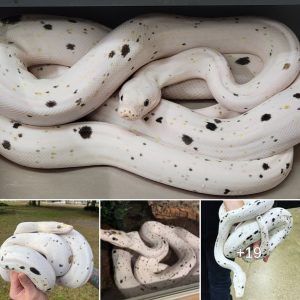
How Deadly is the Copperhead?!
Copperhead
Scientific Name: Agkistrodon contortrix
Classification: Nongame
Abundance: Statewide

The copperhead is familiar, at least by name, to most North Carolinians. Deriving its common name from its coppery brown head, the copperhead also is known by such local names as “pilot,” “chunkhead,” “poplar leaf” and “highland moccasin.”
The copperhead is a rather heavy-bodied snake with an average adult length between 2 and 3 feet. It has a light brown, coppery or tan (sometimes grayish or pinkish tan) background color, with strongly contrasting chestnut brown crossbands shaped like an hourglass or dumbbell—narrow in the center of the back and wide along the sides. Individual patterns vary—sometimes the bands may break up along the center, and some specimens have small dark spots between the bands—but nearly all individuals have at least some complete, hourglass-shaped crossbands. The head is somewhat triangular, quite distinct from the neck, and tan or copper in color, with a thin, dark line running from the eye to the rear of the jaw. The pupils are vertical and elliptical, and there is a heat sensory pit between the eye and nostril. The top of the head does not have a pattern. The belly is usually whitish or yellowish white, sometimes mottled or stippled with brown or gray, with a series of dark brown or black spots or smudges along the sides. The dorsal scales are keeled, and the scales beneath the tail are usually undivided, except at the tip. The body is relatively stout and slightly triangular in cross section. Hinged, recurved, hollow fangs are present in the front of the upper jaw.
Copperheads mate in the spring and fall. Females give birth to 3 to 14 (up to 20) live young during the late summer or early fall.
The copperhead is classified as a nongame species and has no open season. It is unlawful for any person to take, or have in possession, any nongame mammal or bird unless that person has a collection license or is collecting fewer than 5 reptiles or fewer than 25 amphibians that are not endangered, threatened, or special concerned species.
The copperhead is venomous. The copperhead is the most common and widespread venomous snake in North Carolina. In many areas, including most of the larger urban areas of the state, it is the only venomous snake. Because they are so widespread and tolerate living near people, copperheads account for probably over 90 percent of venomous snakebites in North Carolina. While a copperhead bite is painful and should be treated as serious, it is not considered life threatening. Due to their excellent camouflage, many copperhead bites result from carelessly placing a hand or foot too close to one that is resting, but a large percentage of bites occur when people try to capture, kill, or handle copperheads. The great majority of bites can be prevented by exercising common sense: copperheads should be left alone.
Many people fear snakes and worry for the safety of people and pets when snakes are present. In reality, snakes are shy and pose little to no threat to us when left alone. Snakes in our state only bite humans in self-defense; copperheads must spare their venom for edible prey, and humans are much too large to be seen as prey. When copperheads bite in self defense, they often don’t inject any venom, or “dry bite.” Even young copperheads can dry bite, but also have less venom than adults, so they’re no more or less dangerous than adults. Regardless of its age, putting a snake into a position where it feels the need to defend itself is a recipe for injury. The best response to finding a snake is leaving it alone and giving it plenty of space. In most cases, given some time, the snake will move out of the area on its own.
Like all reptiles, snakes are cold-blooded, meaning that their internal temperature is the same as their surroundings. On a cool day, a snake may not yet have the energy to move away from you and may need more time before it can retreat. If you find a snake on your doorstep, driveway, or somewhere else where it needs to be moved immediately, spraying it with a water hose is an excellent way to get it to move on while also maintaining a safe distance.
The Wildlife Commission does NOT send people out to trap and remove wildlife. The best way to prevent conflicts with snakes is to learn about the species in your area and keep a respectful distance from any you find. There are 38 species of snakes in North Carolina and most are harmless to people. Snakes are an important part of our environment, keeping pests such as rodents, slugs, and insects in check. Plus, snakes provide important food to other animals such as foxes, raccoons, bears, eagles, hawks, and owls. Learn more about coexisting with snakes.
Snakes can be difficult to monitor and survey, as most of them possess great camouflaged patterns and remain hidden within certain habitats. One way biologists monitor corn snakes is through the use of artificial cover materials such as plywood boards, roofing tin, concrete blocks, and other materials. Plywood tends to be better at attracting smaller snake species, while larger snakes are more often found under tin. Snakes will seek out these artificial shelters for thermoregulation and as a result, this method is particularly successful during spring and fall.





